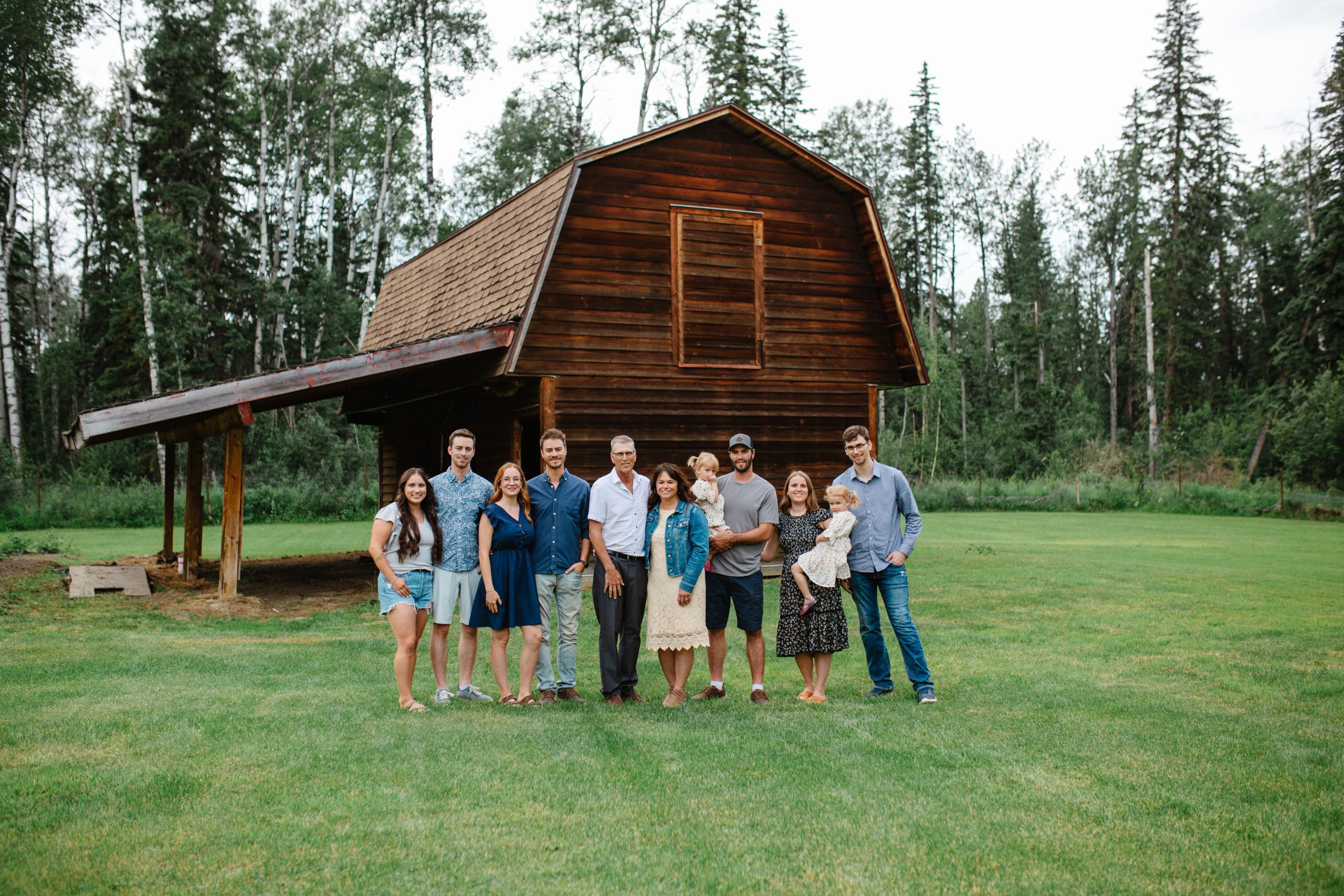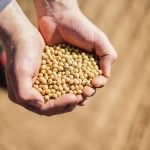It was the trickle of cars driving up their lane that first opened their eyes. If people wanted goat’s milk that badly, said Bruce and Sharon Vandenberg, maybe it wouldn’t be so totally loony to put a couple dozen does in their barn, just as a sideline while Sharon was home with their growing family.
Today, that “couple dozen does” has been transformed into Canada’s largest goat herd. And the “sideline” is Mariposa Dairy, a major farm business, complete with the country’s second-largest goat cheese-processing plant and a market that used to be ethnic but now is completely mainstream, growing by leaps and bounds.
Read Also

The farm transition trial
For anyone affected by cancer, they have likely heard the adage that “a person doesn’t get cancer, the family does.”…
Even stranger, Bruce and Sharon are farm entrepreneurs who cheerfully admit something that entrepreneurs are supposed to hate saying: they could never have done it on their own.
Outsourcing their marketing, they say, got them into more stores and more homes faster and more profitably, opening doors that on their own the Vandenbergs might never have known how to find, let alone how to crack. More than that, outsourcing their marketing let them focus much more of their energy on production and on economics, driving their profitability even more.
But, of course, outsourcing their marketing had to work with how they farm, it had to pay off, and it had to be done smart. And that’s quite a story.
The story starts
Fresh graduates from Ontario’s agricultural college at Kemptville, Bruce and Sharon were newlyweds in 1985 when they bought 100 acres near Lindsay, an hour and a half northeast of Toronto.
The farm’s previous owners had milked goats on a small scale, making cheese and selling it on the farm. It was hardly the reason why Bruce and Sharon bought this first farm, though. The Vandenbergs had never milked goats. In fact, they had never even tasted goat cheese.
Instead, Bruce worked off-farm full-time to pay the mortgage and Sharon began to look around for a farm-based business that she could operate while raising their family.
When customers kept driving up the lane still searching for goat cheese, however, it sparked the couple to drive the two hours to downtown Toronto. There, they found goat cheese in delis, and they encountered a growing ethnic population that was importing expensive speciality cheese.
It looked like opportunity.
In 1987, the Vandenbergs bought a few kid goats with a dream of eventually milking 100 does and making cheese to retail on the farm. Over the next few years, they learned how to manage a dairy goat herd and make cheese. “We had a very fat dog,” laughs Bruce. By 1990, they owned 25 or 30 goats and were doing what they had set out to do, processing cheese and selling it on-farm.
Challenge
Stop the invasion
Soon the Vandenbergs realized they weren’t cut out for on-farm retailing, and vice-versa. “The customers coming onto our farm had no respect for our property, or even Sundays,” recalls Bruce. “Plus they wanted wholesale price, and free farm tours.”
Unwilling to turn their farm over to their customers, the couple drove back to the city, more than once. Now, however, they brought their own samples and they had a specific goal.
They got their foot in the door at a food co-operative, and demand for their goat cheese jumped. Soon they were in other retail outlets too. “At that time, there was no issue with marketing our product,” says Bruce.
Instead, if there was a looming issue, it was how to find enough hours in the day for goats, their growing family (four children in six years) and Bruce’s off-farm job.
In 1993, the Vandenbergs decided Bruce needed to give up his off-farm job to help Sharon run the dairy herd and to also do some crop farming. The couple built a Coverall barn to accommodate more goats. (The barn keeps getting bigger. Today, it’s 480 feet long and holds 1,200 milking does.)
“Demand just kept going up and up and we expanded out and out,” says Bruce. They were in the right place at the right time. According to the Canadian Dairy Council, specialty cheese consumption in Canada doubled between 1980 and 2006, reaching 16 pounds per person.
But this growth wasn’t without its problems. “Again, we got to a crisis point,” says Bruce. “We just couldn’t do it all anymore.”
Instead of giving up on growth, they analysed their financial statements and found a solution off the farm. They hired staff. With extra help in the cheese factory and for milking, they could increase production to meet demand. And demand was about to takeoff.
Challenge
Outsource marketing
The Vandenbergs were ready. Deciding if it’s time to outsource marketing depends on business goals, financial resources, and production and distribution capacity, they figured, and they ticked all those boxes.
In 1996, Mariposa Dairy started talks with Mississauga-based distributor Finica Food Specialities. Food distribution is its own world, based on shrewd business skills and intensive knowledge of the players in the food sector.
The talks with Finica looked to see if there could be a good fit between them, and they also looked for strategies for making the most of that fit. That’s why, as part of their distribution discussions, the Vandenbergs re-labelled their cheese as Celebrity International Goat Cheese. The new brand obligated both companies, so neither party could walk away
“ What we sold (in cheese) in 1990 in a whole year, we sell in three hours today,” says Bruce Vandenberg. “The key to that was hiring outside companies to market our product.”
and introduce a competing product into the market.
Along the way, the Vandenbergs learned more every day about how the food business actually works. Brokers know how to sell. Just as important, they know where to sell. The Vandenbergs also saw how distributing companies will represent a number of products (usually non-competing) so their overhead sales costs would be shared by other manufacturers.
Personal contacts and established relationships with buyers are extremely important in today’s food industry, especially for niche premium products like goat cheese. “The cheapest price doesn’t always sell product, you need a network to sell it,” says Bruce. “That’s what the distributor does for us.”
Generally, food brokers are paid a percentage of sales, ranging from three to 10 per cent, depending on volume and time requirements. Additionally, fees for special services such as the planning of promotions or data collection, or a start-up fee of $1,000 are not uncommon.
For farmers in value-added businesses who aren’t lucky enough to have a distributor or broker seek them out, sourcing a broker can in itself be a roadblock. Before you start thumbing through the yellow pages, the Alberta Agriculture and Rural Development website has a list of food brokers and an excellent fact sheet on finding a broker.
“Small-scale distribution or speciality distribution that helps customize needs is often limited,” says Margurite Thiessen, value chain specialist for the Alberta agriculture ministry.
The way that value-added companies find brokers and distributors depends on each business situation and strategy, says Thiessen. One farm might find a match through a directory or through a government business development agency. Another farm might approach a potential retail customer to find out what distributor they’re using, and then work together to get the product listed by that distributor.
If a customer has a complaint, their brokers handle it. The Vandenbergs don’t have to deal with buyers and only occasionally attend a trade show to support their brokers. However, it’s still important to their business to know their customers, so for the last few years, Bruce has been giving out samples at the Royal Winter Fair in downtown Toronto.
After chatting with consumers, Vandenberg discovered their market had changed tremendously. It’s no longer only ethnic. Increasingly, their target is middle-aged women of all ethnic backgrounds, especially European Canadians. It’s a trend backed up by Agriculture and Agri-Food Canada’s survey of household food expenditures, which reports that women and people with more education and higher incomes are more likely to buy specialty cheese.
Challenge
Linking To A Chain Store
Today, Mariposa Dairy and Celebrity International Goat Cheese have a total of five distributors. Their Celebrity International goat cheese is sold to food service companies and major grocery chains across Canada and throughout the U.S.
“We could produce the milk and process the quality cheese, but getting it out there, that’s what the outside marketing did,” says Bruce. “If we didn’t have a distributor, we simply couldn’t have done this.”
Often, brokers will recommend product sizing and packaging for specific markets. In the Vandenberg’s case, by contrast, it was the flavour suggestions from their distributors that helped take them to the next level, growing their market by expanding their product line.
The Vandenbergs developed a series of innovative recipes, including a cranberry and cinnamon cheese that has been profiled in Toronto Life and that Finica says made “a dramatic explosion onto the Canadian market.”
To the Vandenbergs in the fall of 2002, it felt more like being hit by lightning. One of their food distribution companies called, saying they had a new retail client that wanted their cranberry and cinnamon cheese. But this wasn’t a little deli or an independent grocer in Toronto. This was an international giant.
“He said a chain store — Costco — wanted our product on their shelves, and could we handle it?” says Bruce, still shaking his head in disbelief.
The Vandenbergs didn’t sleep much that night.
Their on-farm cheese plant was only 800 square feet, too small to handle the volume required by Costco. Sharon’s optimism and ability to see an outside solution stopped them from backing out. In this case, what she saw was 5,000 square feet of rental space in the nearby town of Lindsay.
For the next four years, they operated in two sites, making the cheese on the farm and then trucking it into town to be flavoured, packaged and shipped. Their sales grew 10-fold.
Next, with some outside venture capital from a distributor and a few com
“ What we sold (in cheese) in 1990 in a whole year, we sell in three hours today,” says Bruce Vandenberg. “The key to that was hiring outside companies to market our product.”
and introduce a competing product into the market.
Along the way, the Vandenbergs learned more every day about how the food business actually works. Brokers know how to sell. Just as important, they know where to sell. The Vandenbergs also saw how distributing companies will represent a number of products (usually non-competing) so their overhead sales costs would be shared by other manufacturers.
Personal contacts and established relationships with buyers are extremely important in today’s food industry, especially for niche premium products like goat cheese. “The cheapest price doesn’t always sell product, you need a network to sell it,” says Bruce. “That’s what the distributor does for us.”
Generally, food brokers are paid a percentage of sales, ranging from three to 10 per cent, depending on volume and time requirements. Additionally, fees for special services such as the planning of promotions or data collection, or a start-up fee of $1,000 are not uncommon.
For farmers in value-added businesses who aren’t lucky enough to have a distributor or broker seek them out, sourcing a broker can in itself be a roadblock. Before you start thumbing through the yellow pages, the Alberta Agriculture and Rural Development website has a list of food brokers and an excellent fact sheet on finding a broker.
“Small-scale distribution or speciality distribution that helps customize needs is often limited,” says Margurite Thiessen, value chain specialist for the Alberta agriculture ministry.
The way that value-added companies find brokers and distributors depends on each business situation and strategy, says Thiessen. One farm might find a match through a directory or through a government business development agency. Another farm might approach a potential retail customer to find out what distributor they’re using, and then work together to get the product listed by that distributor.
If a customer has a complaint, their brokers handle it. The Vandenbergs don’t have to deal with buyers and only occasionally attend a trade show to support their brokers. However, it’s still important to their business to know their customers, so for the last few years, Bruce has been giving out samples at the Royal Winter Fair in downtown Toronto.
After chatting with consumers, Vandenberg discovered their market had changed tremendously. It’s no longer only ethnic. Increasingly, their target is middle-aged women of all ethnic backgrounds, especially European Canadians. It’s a trend backed up by Agriculture and Agri-Food Canada’s survey of household food expenditures, which reports that women and people with more education and higher incomes are more likely to buy specialty cheese.
Challenge
Linking To A Chain Store
Today, Mariposa Dairy and Celebrity International Goat Cheese have a total of five distributors. Their Celebrity International goat cheese is sold to food service companies and major grocery chains across Canada and throughout the U.S.
“We could produce the milk and process the quality cheese, but getting it out there, that’s what the outside marketing did,” says Bruce. “If we didn’t have a distributor, we simply couldn’t have done this.”
Often, brokers will recommend product sizing and packaging for specific markets. In the Vandenberg’s case, by contrast, it was the flavour suggestions from their distributors that helped take them to the next level, growing their market by expanding their product line.
The Vandenbergs developed a series of innovative recipes, including a cranberry and cinnamon cheese that has been profiled in Toronto Life and that Finica says made “a dramatic explosion onto the Canadian market.”
To the Vandenbergs in the fall of 2002, it felt more like being hit by lightning. One of their food distribution companies called, saying they had a new retail client that wanted their cranberry and cinnamon cheese. But this wasn’t a little deli or an independent grocer in Toronto. This was an international giant.
“He said a chain store — Costco — wanted our product on their shelves, and could we handle it?” says Bruce, still shaking his head in disbelief.
The Vandenbergs didn’t sleep much that night.
Their on-farm cheese plant was only 800 square feet, too small to handle the volume required by Costco. Sharon’s optimism and ability to see an outside solution stopped them from backing out. In this case, what she saw was 5,000 square feet of rental space in the nearby town of Lindsay.
For the next four years, they operated in two sites, making the cheese on the farm and then trucking it into town to be flavoured, packaged and shipped. Their sales grew 10-fold.
Next, with some outside venture capital from a distributor and a few com
“ What we sold (in cheese) in 1990 in a whole year, we sell in three hours today,” says Bruce Vandenberg. “The key to that was hiring outside companies to market our product.”
and introduce a competing product into the market.
Along the way, the Vandenbergs learned more every day about how the food business actually works. Brokers know how to sell. Just as important, they know where to sell. The Vandenbergs also saw how distributing companies will represent a number of products (usually non-competing) so their overhead sales costs would be shared by other manufacturers.
Personal contacts and established relationships with buyers are extremely important in today’s food industry, especially for niche premium products like goat cheese. “The cheapest price doesn’t always sell product, you need a network to sell it,” says Bruce. “That’s what the distributor does for us.”
Generally, food brokers are paid a percentage of sales, ranging from three to 10 per cent, depending on volume and time requirements. Additionally, fees for special services such as the planning of promotions or data collection, or a start-up fee of $1,000 are not uncommon.
For farmers in value-added businesses who aren’t lucky enough to have a distributor or broker seek them out, sourcing a broker can in itself be a roadblock. Before you start thumbing through the yellow pages, the Alberta Agriculture and Rural Development website has a list of food brokers and an excellent fact sheet on finding a broker.
“Small-scale distribution or speciality distribution that helps customize needs is often limited,” says Margurite Thiessen, value chain specialist for the Alberta agriculture ministry.
The way that value-added companies find brokers and distributors depends on each business situation and strategy, says Thiessen. One farm might find a match through a directory or through a government business development agency. Another farm might approach a potential retail customer to find out what distributor they’re using, and then work together to get the product listed by that distributor.
If a customer has a complaint, their brokers handle it. The Vandenbergs don’t have to deal with buyers and only occasionally attend a trade show to support their brokers. However, it’s still important to their business to know their customers, so for the last few years, Bruce has been giving out samples at the Royal Winter Fair in downtown Toronto.
After chatting with consumers, Vandenberg discovered their market had changed tremendously. It’s no longer only ethnic. Increasingly, their target is middle-aged women of all ethnic backgrounds, especially European Canadians. It’s a trend backed up by Agriculture and Agri-Food Canada’s survey of household food expenditures, which reports that women and people with more education and higher incomes are more likely to buy specialty cheese.
Challenge
Linking To A Chain Store
Today, Mariposa Dairy and Celebrity International Goat Cheese have a total of five distributors. Their Celebrity International goat cheese is sold to food service companies and major grocery chains across Canada and throughout the U.S.
“We could produce the milk and process the quality cheese, but getting it out there, that’s what the outside marketing did,” says Bruce. “If we didn’t have a distributor, we simply couldn’t have done this.”
Often, brokers will recommend product sizing and packaging for specific markets. In the Vandenberg’s case, by contrast, it was the flavour suggestions from their distributors that helped take them to the next level, growing their market by expanding their product line.
The Vandenbergs developed a series of innovative recipes, including a cranberry and cinnamon cheese that has been profiled in Toronto Life and that Finica says made “a dramatic explosion onto the Canadian market.”
To the Vandenbergs in the fall of 2002, it felt more like being hit by lightning. One of their food distribution companies called, saying they had a new retail client that wanted their cranberry and cinnamon cheese. But this wasn’t a little deli or an independent grocer in Toronto. This was an international giant.
“He said a chain store — Costco — wanted our product on their shelves, and could we handle it?” says Bruce, still shaking his head in disbelief.
The Vandenbergs didn’t sleep much that night.
Their on-farm cheese plant was only 800 square feet, too small to handle the volume required by Costco. Sharon’s optimism and ability to see an outside solution stopped them from backing out. In this case, what she saw was 5,000 square feet of rental space in the nearby town of Lindsay.
For the next four years, they operated in two sites, making the cheese on the farm and then trucking it into town to be flavoured, packaged and shipped. Their sales grew 10-fold.
Next, with some outside venture capital from a distributor and a few com














